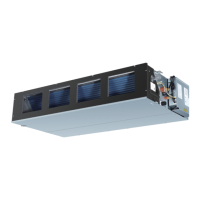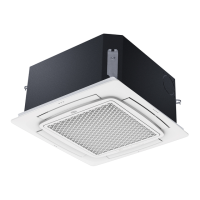To prevent damage to thermostatic expansion valve, remove
sensor bulb from vapor tube while brazing or soldering vapor
connections.
Units have sweat suction and liquid tube connections. Make
suction tube connection first.
1. Cut tubing to correct length.
2. Insert tube into sweat connection on unit until it bottoms.
3. Solder with low-temperature 430°F silver alloy solder.
Wrap a wet cloth around rear of fitting to prevent damage to
factory-made joints.
4. Evacuate coil and tubing system if connections are not made
within 60 sec or tubing package is not used.
Step 6—Condensate Drain
Units are equipped with primary and secondary 3/4-in. FPT drain
connections. For proper condensate line installation see Fig. 4, 6,
7, and 8. To prevent property damage and achieve optimum
drainage performance, BOTH primary and secondary drain lines
should be installed and include properly sized condensate traps.
(See Fig. 14 and 16.) Be sure to install plastic push-in plugs in
unused condensate drain fittings. It is recommended that PVC
fittings be used on the plastic condensate pan. Do not over-tighten.
Finger-tighten plus 1-1/2 turns. Use pipe dope.
Shallow running taps are inadequate and DO NOT allow
proper condensate drainage. (See Fig. 15.)
NOTE: When connecting condensate drain lines, avoid blocking
filter access panel. Prime both primary and secondary condensate
traps after connecting to drain pan.
NOTE: If unit is located in or above a living space where damage
may result from condensate overflow, a field-supplied external
condensate pan should be installed underneath the entire unit, and
a secondary condensate line (with appropriate trap) should be run
from the unit into the pan. Any condensate in this external
condensate pan should be drained to a noticeable place. As an
alternative to using an external condensate pan, some localities
may allow the running of a separate 3/4-in. condensate line (with
appropriate trap) to a place where the condensate will be notice-
able. The owner of the structure must be informed that when
condensate flows from the secondary drain or external condensate
pan, the unit requires servicing, or water damage will occur.
Install traps in the condensate lines as close to the coil as possible.
(See Fig. 16.) Make sure that the outlet of each trap is below its
connection to the condensate pan to prevent condensate from
overflowing the drain pan. Prime all traps, test for leaks, and
insulate traps if located above a living area.
Fig. 11—40FKA Fan Coil with 1—Speed Heat Pump
A98234
O/W2
W/W1
Y1/W2
G
R
O
W2
INDOOR CONTROL
40FKA
FAN COIL
1-SPEED
HEAT PUMP
W1
G
C
Y
R
W2
O
C
DHUM
HUM
B
S1
S2
Y/Y2
R
Y1
C
DH
HEAT STAGE 3
HEAT STAGE 2
HEAT/COOL
STAGE 1
RVS COOLING
FAN
24 VAC HOT
24 VAC COMM
DEHUMIDIFY
HUMIDIFY
RVS HEATING
OUTDOOR
SENSOR
CONNECTION
Y/Y2
HUMIDIFIER
(24 VAC)
OUTDOOR
SENSOR
REMOVE J2 JUMPER
FOR HEAT STAGING
REMOVE
J1 JUMPER FOR
DEHUMIDIFY
MODES
Fig. 12—40FKA Fan Coil with 2—Speed Heat Pump
O/W2
W/W1
Y1/ W2
G
R
O
Y1
INDOOR CONTROL
40FKA
FAN COIL
2-SPEED
HEAT PUMP
W1
G
W2
C
Y2
R
W3
W2
Y1
O
C
DHUM
HUM
B
S1
S2
Y/Y2
R
C
DH
HEAT/COOL
STAGE 1
HEAT STAGE 3
HEAT/COOL
STAGE 2
RVS COOLING
FAN
24 VAC HOT
24 VAC COMM
DEHUMIDIFY
HUMIDIFY
RVS HEATING
OUTDOOR
SENSOR
CONNECTION
Y/Y2
HUMIDIFIER
(24 VAC)
OUTDOOR
SENSOR
REMOVE J2
JUMPER FOR
HEAT STAGING
REMOVE J1 FOR
DEHUMIDIFY
MODES
A98235
Fig. 13—Transformer Connections
A94067
230
C
208
BRN
RED
YEL
BLK
SECONDARY
PRIMARY
9

